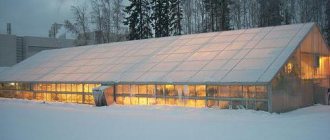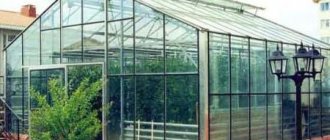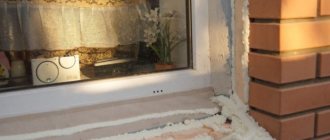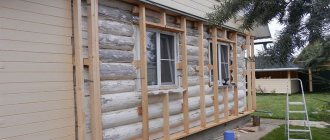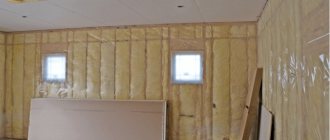Owners of summer cottages and private houses who grow fruits, berries and vegetables often build a greenhouse made of polycarbonate. These structures are necessary to create suitable conditions for crops sensitive to sub-zero temperatures. If you plan to use a greenhouse all year round, then you need to know how to insulate it for the winter.
If you skip this procedure, it will be quite cold in the greenhouse, the ground will freeze very much and there is a high probability that the seed sown in the fall will not sprout in the spring. You can insulate a structure in several ways, the difference between which is in the degree of execution, the cost of labor and financial resources.
Cold bridges and thermal curtains
Perhaps the very first thing to do for insulation is to treat all cold bridges (cracks, joints, attachment points) with heat-insulating compounds. In the autumn-winter period, the greenhouse experiences enormous atmospheric loads, so it is better to use a two-component polysulfide composition as a sealant. Such sealants always remain elastic and are not afraid of any hurricanes or downpours. This unique product has been developed specifically for the maritime sector, where protection from water and wind is of paramount importance.
Sealing gaskets should be installed along the perimeter of the door and window openings - these measures will require minimal costs, but will significantly reduce heating costs. To seal the opening elements, sponge gaskets with glue already applied are used. The gasket elements are installed by applying and pressing them with the adhesive side in the required sealing areas.
Where to begin?
You need to start by choosing the right place to install the future greenhouse. The place should be well lit; shadows from neighboring buildings or trees should not fall on the building. The smoother the area, the better. When choosing a location, you should pay attention to the possibility of protection from the wind, proximity to sources of water and electricity. It is also important to consider a convenient approach.
Proper location of the greenhouse will help save energy resources and avoid heat loss.
How to insulate a polycarbonate greenhouse from the inside in two layers of film
Air is the best heat insulator. Therefore, we need to secure the second layer with bubble wrap along the inner arches of the greenhouse. We choose the densest and cheapest material. Insulating a polycarbonate greenhouse in two layers with bubble film gives the effect of a thermos and reliably retains expensive heat.
Tip 3: Buy film with large bubbles, as shown in the photo in rolls of 100 m2.
Before installing the second layer, take a transparent sealant and seal the overlapping areas of the outer polycarbonate layer.
On the arches inside the greenhouse, it is necessary to secure the film with wire as shown in the photo. We choose the step by eye. The main thing is that the material fits tightly to the arches. Don't forget about overlap.
Video: Option for insulation with a second layer of film
Nowhere without a vestibule
It is impossible to properly insulate a polycarbonate greenhouse without a vestibule at the entrance. In this place there will be a container for watering, an electrical panel, an automatic watering system and a small table for gardening tools.
We make an opening for the door (frame) from 50mm x 50mm timber and attach it to metal structures. The door is knocked down from the same timber and secured to the frame with hinges. For rigidity, we mount a jumper in the middle of the door.
It wouldn’t hurt to buy and glue rubber seals for the doors.
The vestibule lintel and the door are sheathed with 4mm polycarbonate along the second arch. We fasten it, like the second layer in the greenhouse, with screws.
Using transparent sealant we go through all external joints.
A cheaper insulation option is regular film
Infrared heaters
Insulating and heating a greenhouse are different tasks. If we're done with the first step, then it's time to hang up the heaters. The most modern and economical greenhouse heating is infrared heaters. On a 6-meter structure, we attach three panels in the center. Heater power ranges from 0.5 kW/h to 1 kW/h.
Unpack, install fasteners, select the angle of installation, unscrew the cover bolts, 3 bolts, open the cover, hang up the IR heater, look at the connection diagram, install the thermostat, Result 2
It is better to hang 4 panels of lower power than 3 of 1 kW each.
The principle of operation is very simple. The panel heats not the air, but the soil in the greenhouse. The principle of solar heat. For example, for cucumbers, such heating of a polycarbonate greenhouse, and even a properly insulated one, is simply heaven. Plants grow quickly and produce a full harvest even in winter.
The price of infrared heaters for greenhouses ranges from 1800 rubles. up to 3000 rub.
The Leroy Merlin store sells Ballou panels: - 0.6 kW - 2300 rubles - 1.0 kw - 2500 rubles - 1.5 kw - 3000 rubles.
The thermostat will significantly save money on heating a polycarbonate greenhouse. Price approximately 700 rubles.
Installing a thermostat in a greenhouse
It is difficult to understand the connection diagram of the BALU thermostat the first time. A little later I will definitely post a photo from our greenhouse.
Tip 4. Hang the device 1 meter from the beds in the coolest place, not far from the electrical panel.
Another useful device for saving energy is a timer for turning on and off infrared panels. It is especially useful in the spring, when the natural daytime temperature in the greenhouse is sufficient, and the heating is switched on at night.
If possible, install an electric meter to understand the final cost of the winter harvest.
How much electricity does it take to heat a 20m polycarbonate greenhouse?
Answer: For 4 days of the experiment, when the heater and gun were turned on to maintain the temperature at 17-20 degrees - 700 rubles.
Prices for cucumbers and tomatoes in the winter of 2022 exceeded 250 rubles. Yes, and there would be something to pay for. Artificial, tasteless, plastic vegetables will become a thing of the past if you make a small piece of summer with your own hands.
We hope that insulating a polycarbonate greenhouse will not be difficult and will allow you to grow quality vegetables with your own hands all year round.
Where did we start?
What did you get?
Video: heating a greenhouse with your own hands:
Polycarbonate in winter. Two greenhouses at the back of the house.
School repair
Tagkidacha IR panels heating tomatoes Buildings Do-it-yourself greenhouse Insulation
Sealing joints
Joints in the structure between polycarbonate sheets and the metal frame, between the structure and the foundation strip, are one of the main causes of heat loss. To reduce heat loss, roofing felt or waterproofing is placed on the base, but additional insulation of the greenhouse in these places will not hurt. This is also easy to do with your own hands.
To process joints use:
- sealants. The best ones are those that form flexible surfaces rather than hard ones. The latter react poorly to temperature changes and crumble. Various mastics performed well: thiokol, polysulfide;
- rubberized gaskets perfectly seal the gaps between the metal frame and the foundation.
Installation of frame and covering
Having covered the foundation with rolled waterproofing, screw the bottom trim to the studs and then the racks to it.
The greenhouse acquires guaranteed strength with a distance between the posts of 65 cm. But if this option is too expensive, it is allowed to increase the pitch to 1 m. The wooden elements are connected with nails or self-tapping screws.
Additionally, overlays and corners are used. The frame from metal corners is assembled with bolts. From a profiled pipe - by welding. Then it is sheathed with polycarbonate.
There are two mounting methods:
- self-tapping screws. Screwed in increments of 40 cm;
- galvanized tape. With this method, the sheet is held more securely and its integrity is not compromised, but such fasteners are only applicable to arched greenhouses.
The dimensions of polycarbonate strongly depend on temperature, therefore, during installation, compensation gaps are provided for this purpose:
- holes are drilled for self-tapping screws with a diameter 1-2 mm larger than the thread;
- The screws are not tightened too much;
- At the junction of sheets, an H-shaped profile is installed so that the edges of the polycarbonate do not rest against the jumper.
A special thermal washer is placed under the head of the screw to seal the hole and distribute pressure on the plastic.
Cellular polycarbonate cannot be installed so that the stiffeners are located across the slope: condensed moisture will not flow out and the panel will become cloudy, and over time microflora will develop in it. The ribs are positioned along the direction of water flow, while the lower end is covered with perforated tape and a plug so that moisture flows out freely. For the end pointing upward, on the contrary, sealed plugs are used.
An H-shaped connecting profile with seals is used, otherwise the joint will not be airtight.
Internal insulation work
Insulation and treatment of joints do not always solve the problem of heat preservation - the cold still penetrates through the greenhouse material itself, no matter how high-quality it is. Its windows must remain transparent, so coatings that transmit light well are used for internal insulation.
The standard method is to line the space from the inside of the structure with plastic film: a glass/air/film layer is formed that will prevent heat from escaping. Polyethylene is also used externally in the same way.
Installation of an additional layer
In addition to polyethylene, you can use another layer of polycarbonate; sheets of thinner thickness than those that make up the greenhouse are suitable. In this case, a three-layer coating is formed: two layers of material and a layer of air. The standard thickness of external sheets is 16 mm, internal - 4 mm.
You should know that simple polycarbonate does not hold heat well. For greenhouses, the ideal material would be cellular polycarbonate - it works much better as an insulator. Sheets of this material are easy to cut, drill, and are quite flexible.
A few nuances of installing an additional layer:
- the hole to be drilled must be at a distance of at least 40 mm from the edges of the sheet - this way the material will not crack;
- the hole should be 1-2 mm larger than the thickness of the screw;
- For fastening it is better to use a special thermal washer; you can make it yourself. It consists of a sealing washer (made of rubber material), a plastic washer, a self-tapping screw (sold separately), and a thermal washer cover.
What is a winter greenhouse?
It is clear that a winter greenhouse is fundamentally different from a summer one, although its essence remains the same - it should be warm and even hot in the greenhouse.
The very principle of arranging a winter greenhouse is different, it is a much more complex structure, often even equipped with electronics, and you certainly won’t get by with constructing a primitive frame and covering it with film, although something similar will still have to be done.
A winter greenhouse is necessarily a permanent structure that has a foundation that can withstand powerful wind and snow loads. A winter greenhouse can be a full-fledged separate structure or an extension to the wall of a house or other building.
What to grow?
In fact, you can grow anything in a heated winter greenhouse. These can be not only traditional vegetable crops, but also green crops, berries, ornamental crops and various kinds of exotic crops, and, of course, flowers.
| ADVICE It is best to initially decide on the crop that you want to grow in winter and build a greenhouse for it, and not vice versa. |
It is clear that certain cultures require different conditions.
- For example, lettuce and green crops will require a minimum of heating, a minimum of light, but if we are talking about cultivating tomatoes, then more reliable heating and maximum light are needed.
- Do not forget about the proximity of crops, for example, tomatoes and cucumbers are not good neighbors, they have different requirements for moisture, light and temperature, so it is permissible to grow them only in large greenhouses, where their placement can be differentiated.
________________________________________________
Read my article about growing cucumbers in a winter greenhouse ________________________________________________
Preliminary information
Requirements for planted crops
- expediency;
- rationality;
- profitability.
So, expediency.
Do you need this or that culture? And where will you put the surplus if it is formed due to incorrectly planned planting volumes? Rationality implies the correct determination of the timing and volume of planting, and the use of optimal agricultural techniques. When choosing a crop, it is necessary to determine in advance how realistic the owner’s capabilities are to create optimal conditions for growing a given sample.
Expediency and rationality are also ensured by the correct choice of the variety of crop being grown. By correctly selecting the design and arrangement of the greenhouse, and rationally planning the change of plants in the greenhouse bed, you can achieve effective year-round operation of this green conveyor.
Recent posts Chainsaw or electric saw - what to choose for the garden? 4 mistakes when growing tomatoes in pots that almost all housewives make Secrets of growing seedlings from the Japanese, who are very sensitive to the soil
There is probably no need to explain what profitability is. This criterion is important for those who decide to make income from the greenhouse. Greens and flowers, in terms of profitability, are almost the same. But greenery is the solution to the problem of winter vitamin deficiency, flowers are bright shades in the autumn and winter landscape, joy and a peaceful atmosphere in the house.
Classification of crops
Crops grown in greenhouses can be divided into types:
- greenery;
- vegetables;
- roots;
- fruits;
- berries;
- medicinal plants;
- flowers and other ornamental plants.
When organizing a rational process, plants planted in greenhouses are classified into the following groups:
- Predecessor crops, which serve as early-ripening cold-resistant vegetables and herbs. Examples: early carrots (early), radishes, spinach, dill.
- Main crops. They can be tomatoes and cucumbers, sweet peppers and eggplants.
- Intermediate crops serve to fill the space not occupied by the main plantings. As it grows and develops, the main culture gradually replaces the intermediate one. This technique ensures rational use of greenhouse space.
- Winter crops. Examples: sorrel, chicory, parsnip.
In addition to plant foods, medicinal and ornamental plants can be grown in a greenhouse. Both for yourself and, especially, for sale. Examples: roses and peonies, dahlias, nasturtiums, asters.
Installation of a water floor
Before installing a water heated floor, you need to remove a small layer of soil (approximately 40 cm). Some craftsmen recommend removing a smaller layer so that eventually a layer of soil rises above the floor surface. This will greatly facilitate the process of caring for crops. In addition, the soil will receive additional air heating.
Laying a water-heated floor in a greenhouse
Next, you need to perform several steps in the same sequence in which they are listed below.
Heated floor pipe circuit length calculator
Go to calculations
- Compacting the site. It is advisable to walk around the entire perimeter with a roller or compact it with your feet.
- A layer of sand (approximately 8-10 cm) is laid on the compacted surface. Before falling asleep, the sand must be cleared of various shells and pebbles.
- Watering the sand layer. The use of water is required to compact the material. Also, after watering, air bubbles will not appear on the floor.
- Installation of the mounting grid. This is required for subsequent fixation of the heating elements. Thanks to the installed mesh, all elements can be fixed in the desired position.
- Installation of hoses or cables. This is an important stage, since the efficiency of the heating system will depend on the correct installation of the cable. The cable should cover the maximum amount of area, so it is recommended to lay it in a snake pattern.
Pipes for water heated floors
- Installing a temperature sensor. The type and dimensions of the sensor, as well as its installation location, are selected individually.
- Output of all control and power wires.
- Laying the second layer of sand and its subsequent watering. The thickness of the sand layer should also be from 8 to 10 cm.
- Installing a protective mesh and laying a 25 cm layer of soil. The mesh is an important element of the underfloor heating system, since it will protect the heating elements from mechanical damage.
- Connecting a temperature sensor. With its help it will be possible to regulate the temperature of the water in the system. This is the last and most difficult stage of installing a water floor in a greenhouse.
With a warm floor, plants in the greenhouse will be more comfortable
Typical construction
To make a polycarbonate greenhouse correctlyTo make a polycarbonate greenhouse correctly
To install a greenhouse, you should choose a flat, well-lit area away from buildings and trees. It is better to avoid a place with high soil moisture.
Construction is carried out in several stages.
Foundation
The sequence of work is as follows:
- Markings are made along the entire perimeter of the future greenhouse and a trench is dug 0.2 - 0.3 m wide and 0.7-0.8 m deep;
- a layer of sand 0.2 m thick is poured onto the bottom, which is then carefully compacted;
- for waterproofing, roofing material is laid on the sand cushion;
- a reinforcement cage is mounted: rods are laid at the top and bottom of the future foundation and connected to each other by transverse sections of reinforcement;
- formwork is installed, which should be 0.2 - 0.5 m above ground level;
- concrete is poured;
- insulation is carried out with polystyrene foam, a blind area is made.
The height of the formed base is determined by personal preference.
Walls
The sequence of work depends on the type of material used. If you plan to install a finished factory-made product, follow the instructions.
The assembly of the wooden frame begins with a beam of the bottom trim, laid on the base. All timber must be treated with special agents to prevent rotting. The vertical racks are installed in such a way that the edges of the polycarbonate sheets rest on them.
Having installed the vertical posts, check their spatial location and secure them with braces. If the greenhouse is long, several intermediate posts should be provided.
Main walls are laid in one brick. Window openings are formed at a height of 0.5 - 0.75 m from the ground level, maintaining a distance of two to three bricks between them (0.5 m or 0.75 m). The frames installed in them must have transoms to ensure ventilation.
Roof
The gable roof has become most widespread due to the possibility of free flow of atmospheric water. The roof planes have an inclination angle of 20 – 25°. Laying of the lower strapping beams with a section of 120 by 150 mm is carried out along the side walls on the roofing paper. The fastening of the ridge (made from timber of the same size) to the strapping is carried out using paired rafters. For the latter, you can use timber measuring 70 by 100 mm.
Traditionally, double glass with a thickness of at least 4 mm is used to cover the roof. Glazing is carried out using 40 x 75 mm grooves with the formation of gutters for condensate drainage. However, recently, roofing work is more often carried out using cellular polycarbonate. The latter is characterized by lighter weight and ease of installation work.
A greenhouse built using it can last at least 12–15 years.
Features of the construction of an in-depth greenhouse
In addition, the gardener needs to consider:
- Direction of the wind. Air masses create a draft, which is why you have to spend a lot of money on heating the underground building.
- Relief. Many farmers build a buried greenhouse with their own hands on the slopes of hills. Thus, they save on walls and heating.
- Lighting. Trees should not grow near the building, which, with their shadow, prevent the penetration of sunlight.
A universal type of earthen greenhouse is a gable greenhouse with brick walls. The foundation pouring depth is 80 cm when using a strip base. The walls are erected in one brick, coating all joints with waterproofing mortar. At the same time, they are reinforced with vertical metal fixtures. The optimal roof slope is 25˚. It is constructed of glass or polycarbonate. You can even grow garden crops in such a thermos greenhouse.
Project of a lean-to in-ground greenhouse
The greenhouse frame is made of three types of material:
- wooden beams;
- profiled pipes;
- polyvinyl chloride profile.
In such a complex process, diagrams and drawings of the building will become assistants to the gardener. The exact dimensions of a recessed lean-to or gable greenhouse will help the farmer build a reliable and practical building that he will use for decades.
Period of use
To determine what type of industrial greenhouse needs to be installed, you should determine the temporary period of operation of the structure. Two types of industrial greenhouses can be distinguished.
A seasonal greenhouse is suitable for use in the warm season. In the spring, pre-prepared seedlings are planted in the greenhouse, and as they ripen, the harvest is harvested.
The frame of the greenhouse complex is made of durable materials that can withstand frost. To preserve the fertile properties of the soil in the greenhouse in winter, it is recommended to cover the ground with snow.
A year-round production greenhouse makes it possible to generate profits throughout the year. Compared to a seasonal type of structure, such a greenhouse complex requires large financial investments.
The basis of a year-round greenhouse should be a strong foundation that eliminates the possibility of the ground freezing. You will also need to install a heating system and place powerful lighting fixtures. The profit from growing fresh vegetables and fruits, flowers and berries will be many times greater than the initial costs.
Strengthening the structure
When planning the preparation of strengthening a polycarbonate greenhouse, you need to remember to maintain the integrity and strengthen the structure. The shape of the greenhouse is such that snow rolls off easily. In regions with little rainfall, such a greenhouse can easily withstand winter even without reinforcement.
And in areas where there is a lot of snow, it is necessary to further strengthen the greenhouse, in some cases it is even necessary to remove the polycarbonate from the frame.
To strengthen the greenhouse, support pillars are placed inside it, placing them 2 meters apart. If there is excess snow, be sure to clear it off, this will help reduce the load.
In warm sunny weather, the snow begins to melt and roll down, and in the evening, when the temperature drops, it begins to freeze, so it is advisable to remove snow around the entire perimeter of the greenhouse.
Insulation method
An air gap is created for internal insulation. There is a more practical way of insulation - replacing the film with polycarbonate. Thus, heat loss will be significantly less.
If the greenhouse will be used in winter, then it is necessary to consider heating and provide lighting.
For lighting, you can use several types of lamps: conventional, fluorescent and sodium.
When thoroughly insulating a greenhouse, if it stands on a strip foundation, it is worth paying great attention to how the greenhouse frame is adjacent to the base of the foundation. The strip foundation is dug out a little and lined with polystyrene slabs, and then covered with roofing felt on top
At this point, preparing the greenhouse for winter can be considered complete.
Tips for summer residents and recipes for housewives from Yulia Minyaeva Sourdough of cabbage according to the lunar phases: tips and recipes Types of cabbage: characteristics and rules for growing
Advice
After insulating the greenhouse, do not forget and neglect timely cleaning of the structure from snow around the perimeter. By the way, snow can be placed on the ground in a greenhouse and it will serve as excellent moisture for the soil.
As you can see, you can insulate a greenhouse in various ways. If you use at least one of the methods described, or perhaps combine them, then it will not be difficult for you to heat a greenhouse made of polycarbonate, glass or other durable material.
In this video you will learn how to insulate a polycarbonate greenhouse on a budget
Heating a greenhouse for winter use is easy. If you follow the recommendations described in this article, you will achieve the desired result without unnecessary difficulties and costs. Good luck!
Source: ogorodnik.net
Foundation and beds
There is an opinion among gardeners that to create a greenhouse it is not necessary to make a foundation, since it has a small mass and does not need one. This point of view is erroneous, since a prepared base is one of the most effective methods of protecting against soil freezing.
Concrete foundation for a greenhouse
Heat loss will be minimal in the following cases:
- Arrangement of a strip monolithic foundation with insulation. To insulate the structure, polystyrene foam is usually used, covering it with sheets of material.
- Creating a base from timber. It must first be treated with antifungal substances and protected from the negative effects of moisture.
- A concrete foundation is more expensive, but it ensures maximum durability of the entire structure, and when insulated, it protects the soil from freezing. The pouring depth is on average 40-60 cm, the indicator directly depends on climatic conditions. Expanded polystyrene sheets are attached to the bottom of the base and from the outside; for greater reliability, the material is used to cover the tape after removing the formwork.
In addition, it is worth setting up high beds in the greenhouse itself: they are raised to 35-40 cm, and the ground below is covered with a layer of compost.
Soil preparation
When setting up a greenhouse for the winter season, first of all you should carefully prepare the soil. Maximum thermal insulation will be provided by a strip foundation.
Soil preparation can be divided into stages.
- First, the future foundation is marked. After marking, a cast-off is installed, which is usually made from boards. This casting will help determine the internal and external boundaries of the base.
- The next step involves excavating the soil to the required depth. Sand is poured into the bottom of the dug trench to protect the supporting structure. If possible, it is worth taking care of waterproofing the underside.
- Formwork is installed on the prepared trench. The most important requirement is its strength.
- Having decided on the formwork, you can move on to reinforcement. After installing the reinforcing mesh, the structure will become even stronger.
- The last stage is pouring concrete. It is recommended to lubricate the formwork walls with a water-based composition before doing this, so that after the mixture has hardened, it will be easier to separate the elements from it.
What should a winter greenhouse be like?
Winter greenhouses are permanent structures built on a foundation that can withstand both wind and snow loads. These can be either free-standing buildings or extensions with one blank wall. For example, to the utility block, if the orientation of the structure allows.
Foundation
The foundation of a greenhouse can be strip or made of separate blocks; columnar and slab foundations are less common. USPs are usually not made under free-standing greenhouses, but if this is a winter garden within a permanent building, then such a foundation is quite justified. In terms of cost, a slight expansion of the building area against the general background is not critical, and the heating circuit installed when pouring the slab will simplify the further arrangement of the greenhouse.
To prevent the outflow of far from free heat through the base of the greenhouse, extruded polystyrene foam can be used when building the foundation. The most effective is comprehensive insulation of both the foundation strip and the soil under the greenhouse, on the site of future beds. The use of insulation is especially important if soil heating is planned; EPS will prevent unnecessary consumption of thermal energy for heating the lower, unused layers of the soil. You can also use insulation to protect the north side.
For many years I tested different greenhouses and came to the conclusion that they all have one, but significant drawback - they require a large amount of fuel to heat them.
I have been using a winter greenhouse without special heating for several years now. I grow many types of crops and even subtropical and tropical plants in it.
We had to figure out how to get rid of these costs. I dug through a mountain of literature, including old gardening textbooks, and came across an interesting fact. It turns out that in ancient times, greenhouses were made partially recessed into the ground. This provided significant fuel savings.
Taking into account the principle of “deepening”, I built my own greenhouse, which does not need to be heated (see picture). The heat comes from the earth and partly from the sun's rays. True, there is an indispensable condition: the depth must correspond to at least twice the value of the soil freezing index in the given area. Otherwise, you will not achieve the desired thermal conditions.
Profitability
Experts estimate the average profitability of a winter greenhouse at 20%.
When growing flowers and herbs, it reaches 30% and higher, the profitability of vegetable greenhouses is no more than 15%.
Payback periods depend on the size of greenhouses and the level of demand.
To get the maximum benefit from your greenhouse business, you must:
- Choose the right crop to grow. Undemanding greens are suitable for novice farmers; flowers or strawberries are suitable for more experienced farmers. Vegetables should only be grown in regions with a temperate climate and low competition.
- Build a high-quality greenhouse that will not require annual repairs. Structures made from decommissioned double-glazed windows are not suitable for business. Consider the issue of lighting and heating.
- Choose a growing technology. Soil technologies are too expensive, and consumers do not like crops grown hydroponically. A compromise option is hanging growing or shelving technologies. The soil layers are placed in tiers, each equipped with lighting and an irrigation system. Strawberries can be grown in special mats placed in vertical or horizontal plastic sleeves.
- Control the composition of the soil. The greenhouse business requires frequent replacement of the soil; with continuous cultivation and dense planting, it is quickly depleted. It is necessary to apply fertilizer every 2 weeks.
- Use varieties cultivated for growing in greenhouses. They are disease resistant, have a short growing season and excellent yield. It is recommended to focus on the 2-3 most popular varieties, excluding constant experiments with new products.
A greenhouse business can become successful and provide the owner with a constant profit
In order not to be disappointed, it is important to analyze your capabilities long before the start, draw up a detailed business plan and think through the issues of product sales
How to keep warm in a greenhouse
Along with arranging a heating system for a structure, it is also necessary to think about how to retain the resulting heat.
There are several simple options:
- air bubble film (can be used to cover the inside of a structure, retains heat well, protects from drafts, and allows light to pass through);
- dividing the greenhouse into zones (with the same film you can divide the internal space of the structure into separate sections, as a result you can heat individual areas);
- heater if necessary (an electric heater is capable of quickly pumping warm air, which allows you to warm up the room in a short period of time if the temperature has dropped sharply);
- thermostat (allows you to maintain the temperature at a certain level);
- geotextiles (plantings can be insulated using this material; it retains heat well and reduces the frequency of turning on the heater).
Insulating greenhouses is an important and troublesome task. It is best to combine it with the construction of the structure, as it will take less time and effort
In addition, you won’t have to think at the last moment about how to do everything.
Was this article helpful?
Thank you for your opinion!
You can recommend this article to your friends!
Already helped once
Tillage
You can insulate the soil with your own hands using heat-insulating material. It is used to separate the cold from the top layer of the earth, which will be heated by light and air. It is better to start preparing the soil in the spring, when it has already warmed up sufficiently. Typically, twigs, shavings, sawdust, planks, etc. are used as heat-insulating material.
Leaves should not be used - they decompose quickly. The insulation is not buried deeply. For most garden beds, leaving 20 centimeters of soil will suffice.
The described biological heating functions as follows.
- First, organic substances begin to decompose under the influence of natural processes. At the same time, thermal energy is released.
- The heat rises, simultaneously heating the soil.
- It is worth noting that instead of natural material, you can use artificial one. For example, you can insulate the soil with penoplex.
Emergency insulation of the structure
Often, summer residents are faced with the need to urgently warm up the greenhouse. This situation can arise, for example, if there is a sharp drop in temperature or mechanical damage to the structure, as a result of which it becomes too cold inside. Emergency methods of warming up are chosen based on budget and capabilities, and are often combined with additional work.
Urgent insulation of a greenhouse
For example, urgent insulation can be carried out along with disinfection; For the last action, various methods are used, including sulfur fumigation. This procedure allows you to remove fungus and harmful microorganisms that grow in the soil and on the walls due to high humidity and high temperature. For this purpose, a sulfur block for a polycarbonate greenhouse is purchased; one piece is enough for 20 cubic meters of space. The insulation process can be combined with burning it; this will not harm the plants.
The emergency warm-up itself is performed as follows:
- The dome of the greenhouse must be covered with rolled material: it can be a film with a foil surface, tarpaulin, roofing felt, dense polyethylene.
- The outside needs to be filled with sand. It is done around the perimeter of the entire foundation; a mixture of leaf and sawdust can be added to it.
- Foam panels are installed inside along the length of the base. To protect them from condensation, it is recommended to wrap the sheets in geotextile or other material with a non-woven backing.
- The entrance will need to be equipped with a homemade vestibule: to do this, it needs to be covered with plastic film. If you don't have one, a tarp will do. In the same way, you need to close the holes used for ventilation.
- Inside the greenhouse, barrels containing humus mixed with shavings are installed. Containers should be filled to ½ full. The gradual decomposition of organic matter will lead to an increase in atmospheric temperature.
- To speed up the process, you can place a portable heater inside that runs on gas fuel. It is enough to turn it on for 1-1.5 hours for the temperature to rise to the desired level.
Emergency heating will help preserve seedlings and protect seeds if frost unexpectedly strikes, for which the structure was not originally designed.
It is recommended to take care of the insulation of a polycarbonate greenhouse during the construction stage. If after construction it turns out that the air inside is cold or the soil may freeze, it is necessary to seal the cracks and install an active and biological heating system. Competent actions will maximize the protection of the building from heat loss.
Insulation of a winter greenhouse - on video:
Additional heating tools
The range of opportunities for owners of greenhouses and greenhouses is enormous. Using heating equipment, you can easily create ideal temperature conditions inside the structure. Devices of this type can be used both for stationary buildings and for greenhouses attached to the walls of cottages or houses.
Autonomy. Gas equipment
Buyers have the opportunity to purchase heating equipment that operates autonomously. Gas is used as a resource. Such devices are designed for installation in stationary greenhouses. To install heating, you need to connect it to a common gas pipeline. This complex process should only be carried out by professionals. In addition, the additional branch requires appropriate permission.
If it is not possible to connect the system to a gas pipeline, you can use cylinders, but this is not the most economical and convenient option. Gas runs out quickly, and you have to constantly spend time purchasing new cylinders. As practice shows, one container lasts less than a month.
Electricity
The second option is electric heaters. Such equipment has its pros and cons. The main advantages are safe use, compared to gas heating, simple operation and installation. The disadvantage is that to heat the air in a large greenhouse, you will need several devices. Don't forget about electricity costs. Using standard household appliances will not lead to the desired result, since they are not designed to be used 24 hours a day. The equipment will not cope with the constant load and will quickly become unusable.
Insulation of polycarbonate structures
Polycarbonate greenhouses are becoming more common. They can be found in various regions of our country
Polycarbonate is durable, reliable, practical and, most importantly, cost-effective material. It is great for creating greenhouses for various plants
The more severe the climate in a particular region, the more seriously you need to take the process of insulating a building. This will help to significantly increase the yield and growing season of flora representatives.
Sheet polycarbonate, which has become widespread as a material for greenhouses, boasts excellent thermal insulation. This is the first advantage of this finishing material, because the main task of the greenhouse is to create comfortable conditions for plants and their development. The second thing to note is transparency. The sun's rays pass through the walls unhindered. Don't forget that light also gives warmth. The material will help save money spent on using lighting equipment.
To achieve maximum heat retention, it is recommended to opt for a three-layer coating. The design includes two layers of polycarbonate and an air layer as an addition. The optimal thickness of the outer sheets is about one and a half centimeters, 1.5 cm, and the inner layer is 4 mm. To reduce heat loss, experts recommend using polycarbonate sheets together with rubber seals.
Foundation
Be sure to pay attention to the lower part of the structure, including the foundation. It should be laid in the same way as when working with greenhouses made of other materials.
The depth should not be less than the freezing depth of the soil. When arranging foundation blocks, it is necessary to use roofing material; it is laid on top of the foundation. Additional insulation is also carried out from the inside. In this case, you will need a 40 cm layer of sand and polystyrene foam.
Greenhouse placement
Smart placement will help save heat inside the greenhouse, which will also save heating and maintenance costs. There are several rules that should be followed when choosing the location of the greenhouse.
Sun. An area illuminated by natural light is the best place to place a greenhouse. Natural light and warmth are essential for the harvest.
- Area. In the northern regions, greenhouses must be directed in the direction from east to west.
- Shadow. Shading of the structure should be minimized as much as possible.
- Block. The house, trees and other additional buildings in the yard can be used as protection from wind and drafts.
Additional Methods
There are many other ways to insulate a greenhouse.
Beds. Experienced summer residents and gardeners recommend using high beds. The optimal figure is 40 centimeters.
Greenhouse insulation with polystyrene foam
In recent years, polycarbonate structures have become widespread. To insulate the soil in them, experts recommend some modern materials, including extruded polystyrene foam. In the construction industry it is used for thermal insulation of various structures. Excellent thermophysical properties make it suitable for insulating soil in a greenhouse.
From the point of view of arranging a greenhouse, polystyrene foam structures have the following undeniable advantages.
- Low thermal conductivity. Compared to the more common polystyrene foam, this figure is half as high. Thus, it is possible to maintain a stable temperature regime inside the greenhouse. As a result, the fertile soil layer also warms up.
- Little moisture absorption. Accumulating condensation can cool the ground. Insulating the greenhouse with expanded polystyrene slabs helps minimize this effect. Moisture can only accumulate in the upper layers of the material; thanks to the structure with very small pores, it does not penetrate into the depths.
- Long service life. By insulating the greenhouse structure with polystyrene foam boards, the problem of soil freezing can be solved for many years to come. The material can even be laid on the ground, which is especially important for insulating the fertile soil layer. From it you can construct a kind of air cushion, by analogy with the layer of brick described above. The compositional features of the material allow it to maintain a stable shape and characteristics.
Thus, the problem of soil insulation can be solved in several ways. Our specialists will help you choose the most suitable option for a particular site from all points of view.
Second layer of thermal insulation
Effective insulation of greenhouses is carried out by installing a second film layer. Polyethylene film is the most accessible and cheapest material. Today, modern markets offer stabilized films with high levels of wear resistance, elasticity and frost resistance.
It has excellent transmission capacity for ultraviolet rays and oxygen; has a light-scattering effect, which is important for greenhouse crops; resistant to dust formation. Manufacturers of film products guarantee a service life of the film coating of up to 7 years (Richel - PE film)! Such a service life has not been observed in any known film of previous years.
The quality of new generation materials cannot but please greenhouse owners.
Ethylene vinyl acetate copolymer film is ideal for insulating a greenhouse structure - a particularly durable material with a light transmittance of 92%.
Various methods of sealing glazing: a - using sealing mastic; b - putty-free glazing; c - using a sealant; g - fastening the glass to the T-section sprocket; d - fastening glass with putty to a wooden sprocket; e - connecting glass using a clamp; 1 - glass; 2 - sprats; 3 — clamps; 4 - sealing mastic, putty or sealant; 5 — clasp KL-3; 6 - pins
Characteristics of copolymer film:
- resistance to wind loads and punctures;
- long service life;
- excellent light transmission;
- strength;
- frost resistance;
- elasticity;
- antistatic properties (dust repellent);
- hydrophilic surface (condensation rolling off);
- energy saving up to 40%.
A simple frame made of wire, metal or plastic pipes (whatever is at hand) is installed inside the greenhouse. The frame structure must have 5 cm indentations from the main walls of the greenhouse. The air cushion that appears between the walls of the main and additional frames reduces heat loss by up to 50%. Significant energy savings are guaranteed only if tightness is maintained at the joints and fastenings of the film - special clip locks (Richel) and sealants (polyurethane, silicone) have been developed for this purpose.
Microclimate support system
An all-season greenhouse model must have a system for maintaining an optimal microclimate for plants, in hot and cold weather.
Greenhouse heating
Various types of heating systems are used to heat rooms:
- Electrical - imply that the building has the ability to connect to the electrical network. They are represented by all kinds of convectors, fireplaces, etc.
- Stove rooms are located at the entrance and imply the presence of a high-quality supply and exhaust system.
- Water - are a water heating tank that transmits heated liquid through a system of pipes located along the entire perimeter of the building.
- Gas - are gas burners and heaters.
- Air - involves laying a hose that supplies a flow of warm air around the entire perimeter of the greenhouse. Such a system can heat an area of any size in a few minutes, but it reduces the humidity too much.
- Infrared - represented by appropriate heaters and lamps. This system does not dry out the air and is economical in energy consumption.
Important! In order to avoid the spread of fungal diseases, immediately after completing all work, it is necessary to carry out a final disinfection treatment of the finished greenhouse with an antiseptic
Soil heating
Heating the soil is best done biologically. To do this, even before starting construction, 30–40 cm of soil is removed throughout the entire territory. Then add 10 kg of fresh mullein, or even better horse manure, and compost for each 1 m². After this, the removed soil is returned to its place. When overheated, biomaterials will release heat and warm the soil to the optimal temperature.
Irrigation system
When equipping an irrigation system, you need to understand that regardless of the source of water supply, it must first be prepared for use:
- defend;
- warm up to ambient temperature;
- if necessary, add mineral fertilizers or soften.
In this regard, you will have to take care not only of connecting to a water source, but also of the presence of storage tanks, as well as a supply system. As a source, you can use a water supply or a well equipped with a pump. The type of irrigation system is selected according to the type of plant.
In total, there are 4 types of irrigation systems:
- drip;
- sprinkling;
- fogging;
- flooding.
In greenhouses intended for private use, watering and irrigation can be done manually.
Lighting and shading
In the autumn-winter period, most crops will have to be illuminated. The optimal length of daylight for plants is 10–14 hours.
Suitable for additional lighting:
- gas-charging sodium lamps (DNaT, DNaZ) - suitable for large premises; to connect them, you must first equip a trigger mechanism;
- mercury lamps (DRI, DRIZ) - not entirely safe due to the toxicity of the mercury contained inside;
- fluorescent lamps - most plants respond positively to additional illumination with such equipment;
- LEDs - lamps do not heat up when connected, so they can be located in close proximity to the plant organism, but have a high cost;
- night lighting lamps are lamps of the green spectrum, the light of which the plant organism does not perceive as daylight, and therefore is at rest; they are advisable if you need to carry out agricultural work in the greenhouse in the evening.
Vegetables with reduced daylight hours and most flowers require shade. For this purpose, curtains, vertical or horizontal, are organized in greenhouse buildings. The first type involves curtaining the walls with a thick, light-proof fabric, the second - the ceiling.
Energy saving screens
Horizontal curtain systems for greenhouses at night are another way to retain heat. A heat shield made of aluminum fiber fabric (ALUMINET) prevents the cooling of greenhouse structures. Under the influence of reflective components (aluminum has a high heat-reflecting ability), the infrared heat of the earth accumulated during the day is returned back to the greenhouse. When using screens with aluminum elements, heating costs are reduced - 50% energy savings are achieved. The greenhouse can be left covered with a heat-reflecting screen for 16 hours, since daylight hours in winter are only 8 hours.
There are other screens with a lower percentage of energy savings. For example, diffuse or shading curtains (such as LS 10) save 40% of energy, and film curtains save 30%. Polyethylene screens are installed permanently.
Horizontal shading is installed in separate sections under the roof of the greenhouse. All sections of the screen are driven synchronously by a special curtain mechanism - a cable drive or rack and pinion drive is used for this. There is also vertical shading, but it is still less common.
Automated curtain systems are suitable for industrial-scale greenhouse structures, and for small greenhouses you can design a screen yourself that will work on the principle of a roller blind. The heat-insulating material is attached to a horizontal shaft (aluminum pipe) with a drum mechanism and wound into a roll. Fastening elements are installed on the other end of the canvas. The shaft with the roll is fixed under the ceiling of the wall opposite to the entrance. As needed, the canvas is unwound under the surface of the greenhouse in approximately 1 m increments. All components of such an energy-saving roller blind can be found freely available at any hardware store.
